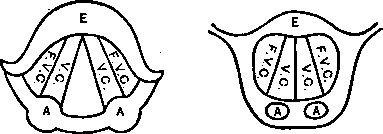Voice Training In Speech And Song - online tutorial
The Structure And Use Of The Vocal Organs, And The Means Of Securing Distinct Articulation.
| Share page | Visit Us On FB |
|
THE VIBRATOTIY APPARATUS. 11
voice it becomes wide and consequently more triangular (Fig. 6). In phonation it is almost closed by the approximation of the cords (Fig. 7). Small muscles inside the larynx attached to the arytenoids cause the glottis to change in shape; they by contraction rotate the arytenoids upon the cricoid (Fig. 9). The lateral crico-arytenoids rotate the arytenoids inwards and approximate the cords, |
||
|
|
||
 |
||
|
|
||
|
Fig. 6.—The Glottis. Fig. 7.—The Glottis.
Open as in the breathing for action. Almost closed as in phonation. VC,
Vocal Cords; FVC, False Vocal Cords; E, Epiglottis; A, Top of the Arytenoids. |
||
|
|
||
|
In each diagram the space between the Vocal Cords is the Glottis, and the space between the Vocal Cords and the False Vocal Cords is the opening into the Ventricle of Morgagni.
the posterior crico-arytenoids rotate the arytenoids outwards and separate the cords (Fig. 9). The arytenoid muscle draws the two arytenoids together (Fig. 8).
18. Fitch.—The crico-thyroid muscles stretch the vocal cords and raise the pitch of the note by raising the front of the cricoid towards the thyroid, and consequently depressing the back of the cricoid with the arytenoids (Fig. 2). Thus the distance between the back of the angle of the thyroid and the vocal processes of the arytenoids is increased and the cords are stretched.
The thyro-arytenoid muscles attached to the thyroid in front and to the arytenoids behind, lying alongside each |
||